ReImagine Washtenaw progress: Survey in progress, major changes likely years away
Editor's note: The caption for the lead photo has been edited to reflect it was taken in Ann Arbor.
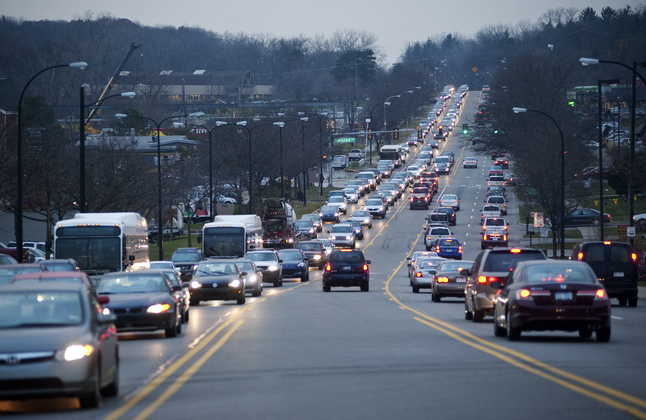
Traffic crowds Washtenaw Avenue Tuesday evening in Ann Arbor. The ReImagine Washtenaw initiative is trying to make the busy corridor friendlier to other modes of transit.
Daniel Brenner I AnnArbor.com
With four years of planning under the belt of the ReImagine Washtenaw initiative, a study is now in progress that could dictate the future configuration of 4.5 miles of Washtenaw Avenue from Stadium Boulevard in Ann Arbor to the water tower in Ypsilanti.
The goal of the initiative is to make the corridor friendly to all modes of transit, and to change the way businesses are built to make them more accessible to pedestrians.
Nathan Voght, project manager for ReImagine Washtenaw, said development change in connection with the initiative will likely begin with road improvements as the catalyst.
However, major changes to Washtenaw Avenue are likely more than five years away.
The vision
ReImagine Washtenaw is a multi-jurisdictional “placemaking” effort to make the corridor friendlier to buses, bicyclists and pedestrians. The stretch of Washtenaw Avenue from Ann Arbor to Ypsilanti has the highest housing density in the county, Voght said.
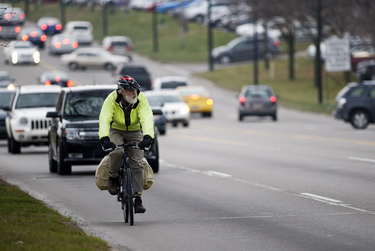
A bicyclist rides with traffic Tuesday on Washtenaw Avenue in Ann Arbor. ReImagine Washtenaw would add a bike lane or multi-use pathway to make it safer for people to bike in the corridor.
Daniel Brenner I AnnArbor.com
“We’re trying to go from a corridor that everyone endures and tolerates to one that they want to live on and enjoy,” Voght said.
Ann Arbor, Ypsilanti, Ypsilanti Township, Pittsfield Township, the Ann Arbor Transportation Authority, the Michigan Department of Transportation and Washtenaw County have all been working together to seek public comment and find funding sources for the initiative. So far, they’ve been met with a positive reception.
A bill sponsored by Rep. Jeff Irwin, D-Ann Arbor, and Rep. Mark Ouimet, R-Scio Township, was signed into law at the end of June that will allow the creation of a Corridor Improvement Authority for Washtenaw Avenue.
The authority could divert some property taxes in the district to fund specific improvements in the corridor. However, no conversations to form such an authority are under way, Voght said.
The new Arbor Hills Development project — a 90,700-square-foot complex at Platt Road and Washtenaw Avenue — is a prime example of the kinds of commercial buildings ReImagine Washtenaw is working to promote. Workers broke ground on the project this year after it received full approval from the Ann Arbor City Council in late 2011.
Voght said there are certain intersections along Washtenaw Avenue that are more ripe for development than others: Golfside Road, Hewitt Road and Huron Parkway.
Many people ask Voght why ReImagine Washtenaw is even attempting to change the traffic-heavy route.
“That’s a really pessimistic view for the corridor. Why do we continue to make decisions and investments that don’t keep people safe?” Voght said. “Adding more lanes invites more traffic.”
The funding
Funding the improvements to the corridor will be the main challenge for the entire project.
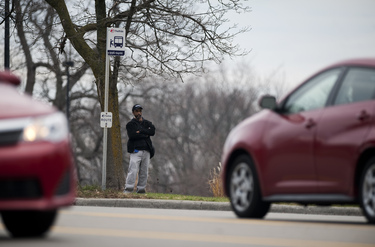
A pedestrian waits at a bus stop on Washtenaw Avenue in Ann Arbor on Tuesday.
Daniel Brenner I AnnArbor.com
AATA has received $2.6 million from the federal government for improvements related to the ReImagine Washtenaw project. The grant is to purchase clean diesel buses with hybrid-electric components to increase transit service frequency on Washtenaw Avenue — a corridor that sees about 1 million bus passengers per year, Voght said.
Washtenaw County also has some money in play, as the county’s Office of Community and Economic Development has received a $3 million grant from the U.S. Department of Housing and Urban Development. About half of a million of that grant has been allocated to ReImagine Washtenaw, Voght said.
About $250,000 of that allocation is being used for a right-of-way and transit stop design study, which launched in October and will end in summer 2013. The county has hired SmithGroupJJR and Parsons/Brinckerhoff for the work.
The survey will determine the traffic flow through major intersections in the corridor, as well as modeling to show how different configurations of bike lanes, sidewalks, bus lanes and mid-block crossings could affect traffic. The models will assume more people will be walking, biking and taking the bus in their travels in the corridor and that less people will be driving a vehicle.
The study conducted by transportation engineers will also provide designs of eight AATA “Super Stop” locations.
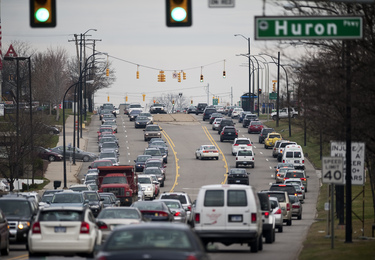
Traffic on Washtenaw Avenue near Huron Parkway in Ann Arbor on Tuesday.
Daniel Brenner I AnnArbor.com
“The more efficient and reliable you make public transit, the more riders you get,” Voght said.
Future traffic configurations will not make Washtenaw Avenue intersections less efficient than they are now, Voght said. The intent of the study is to generate an agreement that will be used to determine future decisions.
“We want to be able to hand everyone the plan that we all agreed to,” Voght said.
The right-of-way study will be completed by June. In March, several public meetings will be held to get comments on streetscape designs.
The other $250,000 is being used to hire consultants to revise master plan language and zoning ordinances for the townships of Pittsfield and Ypsilanti, which should be completed by June. The city of Ypsilanti’s master plan is being completely revised and will be overhauled in about 18 months, Voght said.
The master plans will be updated with progressive zoning language to stipulate for zero lot line development and buildings that are higher-density, mixed-use properties. Voght said the county has hired Pittsfield Township’s planning consultant to make sure the updates to all three master plans are in sync.
Ann Arbor’s master plan is up-to-date enough that it did not need to be re-worked, Voght said.
Public and private investment
With the updates to the zoning ordinances, Voght admitted that some businesses may be deterred from buying property or making updates to properties in the corridor.
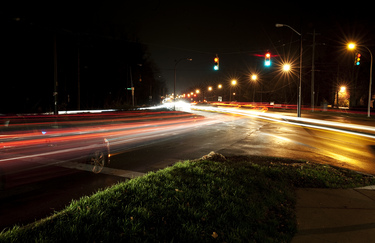
Cars stream through the intersection of Washtenaw Avenue and Stadium Boulevard Tuesday night in Ann Arbor. The intersection is the beginning of the area that ReImagine Washtenaw wants to improve.
Daniel Brenner I AnnArbor.com
“They don’t get that a more walkable neighborhood would get them more business,” Voght said.
The current auto-oriented configuration along Washtenaw Avenue limits commerce, Voght said.
“You can’t park in (a business’ parking lot) and get to more than two stores,” he said. “The challenge is, who’s the first guy that comes in and builds this?”
Businesses will be offered incentives to fit the model of development the ReImagine Washtenaw planners are seeking. The building process will be expedited for developers that conform to the zoning standards, Voght said.
Voght said he believes private businesses will be attracted to invest in the corridor after a public investment is made to change the streetscape of Washtenaw Avenue — which will take significant funds.
“Public investment begets private investment,” Voght said. “We prefer improvements be done right, and wait for sufficient funding to do it right.”
MDOT's role
Washtenaw Avenue, a state-owned roadway, is currently rated in good condition. The portion in Ann Arbor was last re-paved in 2008, and the section from US-23 east to Ypsilanti was last re-paved in 2009.
According to MDOT, there are no plans in the next five years to reconstruct the roadway.
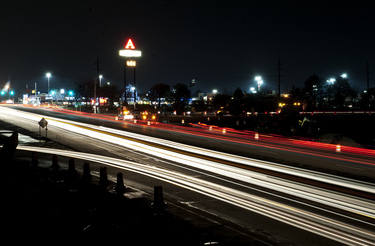
Cars leave streams of light Tuesday night on Washtenaw Avenue near Interstate 23 in Ann Arbor.
Daniel Brenner I AnnArbor.com
MDOT is currently in the midst of a $2.27 million construction project on Washtenaw Avenue at the US-23 interchange to add a mutli-use path on both sides of the road underneath the highway from Carpenter Road to Yost Boulevard.
MDOT typically makes its decisions on where it will re-construct roads based on pavement conditions, Martin said.
The department’s budget for 2012 to 2016 is set. Martin said the next version will be updated next year for 2013 to 2017.
MDOT’s complete streets initiative aligns well with ReImagine Washtenaw’s goals, Martin said.
“We’re trying to make roads for all users,” Martin said.
Martin said MDOT would consider the plan set forward by the ReImagine Washtenaw as along as operationally, it fits the needs of the road and if funding is available.
“At the end of the day, it’s (MDOT’s) road,” Voght said. “Some communities want the road back, but it’s not being talked about right now.”
Amy Biolchini covers Washtenaw County, health and environmental issues for AnnArbor.com. Reach her at (734) 623-2552, amybiolchini@annarbor.com or on Twitter.


Comments
talker
Sat, Dec 8, 2012 : 1:10 a.m.
Multiple bags of groceries can't be balanced safely on a bicycle. In addition, parents of children can pull their children safely on a busy road. Besides, many people who patronize businesses on Washtenaw have come from parts of the city and nearby areas that are over three miles away. It would not be practical to ride a bike down Huron Parkway from the Plymouth Road area, whether with or without a child. Without customers from farther away than a mile or two, there wouldn't be many businesses on Washtenaw. Also, many people, especially those older than 40, 50, 60, or 70 may not be able to ride bicycles for more than a mile. Ann Arbor may be a college town, but it's also home to people of all ages. People of all ages need to drive on Washtenaw and Washtenaw businesses need people of all ages. Sometimes these impractical proposals seem like the ideas I had 40 years ago. Now, my attitude is that anything I and other taxpayers will have to pay for should be improvements. The goal here should be to improve the flow of traffic, not impede it.
Roger Kuhlman
Thu, Nov 29, 2012 : 2:51 a.m.
All sizzle and no substance?
snapshot
Tue, Nov 27, 2012 : 8:31 a.m.
ReImagine.....just doesn't look right...the capital I looks like an L to me. Re-Imagine would make more "sense" to me. However "improvement" or "renovation" project would seem more appropriate. Driving in Ann Arbor is a nightmare or am I just imagining it. No, I just ReImagined it and it's still a nightmare.
Macabre Sunset
Tue, Nov 27, 2012 : 2:20 a.m.
There's now a crosswalk of death complete with a new light on the exit ramp from 23 to Washtenaw. There are stop signs elsewhere that will be about as effective as attempts to educate bicyclists about how to use the road. Why are city planners trying to worsen traffic at the worst designed intersection in the city (Carpenter/Washtenaw/23)? Is the idea to destroy business by making the area so miserable to traverse that no one is willing to stop for fear of not being able to get out of the gridlock?
Daniel Soebbing
Tue, Nov 27, 2012 : 3:08 a.m.
Whatever. The right wing cranks have been calling it "The People's Republic of Ann Arbor" for as long as I've been alive. I don't know when Ann Arbor enjoyed that "All American City" status, but it must have been some time before the sixties.
Michigan Man
Tue, Nov 27, 2012 : 2:40 a.m.
MS - Sound logic + Persuasive writing - I really long for the back in the day All American City status enjoyed in Ann Arbor.
Michigan Man
Tue, Nov 27, 2012 : 12:38 a.m.
Well I might as well weigh in again on this matter - I really, really thought Ann Arbor had the smartest people in the USA living in town - having trouble connecting the dots between this project and the smartest people in the nation. Looking at the picture above would motivate me to move to Dexter. Go west young man, not east toward Detroit!
Halter
Mon, Nov 26, 2012 : 11:17 p.m.
@Veracity --- dead on, thank you. Personally, I think there is a huge huge misperception as the starting point...that is that increasing pedestrial/bicycle/bus assessibiity here will somehow magically decrease auto traffic --- HOW WRONG is that? It will just add all that on top of the current traffic load and probably even increase it if the area becomes more attractive and easier to navigate. What needs to be looked at is that awful 23/Washtenaw interchange -- which is a massive pile-up accident waiting to happen one day (and is already one-half block from the worst intersection in Washtenaw County for accidents (Carpenter and Washtenaw)... The study really should be looking at 23, not Washtenaw. The aforementioned exit is a disaster. The Geddes Road exit is basically for the hospital and residential use. Perhaps a new exit at Packard/23 needs to be considered as an option. But to somehow think that traffic will decrease on Washtenaw is just a fallacy from the getgo.
talker
Sat, Dec 8, 2012 : 12:57 a.m.
I've had to abort getting on U.S. 23 more than once. In those cases, I was entering the northbound ramp when I'd been eastbound on Washtenaw. When traffic in the right land was continual, I've chosen to exit rather than crash. Exit 37 doesn't meet interstate requirements, which are the preferable criteria for any busy freeway.
Macabre Sunset
Tue, Nov 27, 2012 : 2:16 a.m.
I'm not sure, but I think under current national law, another interchange so close by would not be allowed. There are many, many pieces of 23 that could not be built today as they exist today. 23 is a mess that desperately needs a third lane. But, thanks to Jenny, it wasn't built when it needed to be built.
Halter
Mon, Nov 26, 2012 : 11:23 p.m.
Incidentally, the way most cities manage these types of problems is to reconfigure and do one-way roads.... One option: Build a new exit at Packard/23...all traffic on Washtenaw flows east to west until Platt/Huron Parkway...two ways on Platt/Huron parkway....All Traffic flows west to east on Packard to the new entrance ramp...Carpenter remains two-way.....In essence creating a "loop" in which traffic flows more easily in all directions
Jayzoh
Mon, Nov 26, 2012 : 10:18 p.m.
I live in A2 not far from the stadium/washtenaw split, and find myself driving the corridor frequently for all sorts of reasons: I shop and need TJ's, WholeFoods, Hillers, and then loads of things at the Asian market further east on Washtenaw in Ypsi, and then maybe continue to Meijerson Carpenter for other items. Other times, I am on Washtenaw for the Rec Center, followed by something at EMU, then back again to Arborland to make returns and purchases at BedBath or DressBarn.etc. etc.. I have no one single purpose on the W.. corridor. A car is the way to go, when there are so many stops, such a variety of disparate activities and destinations. Waiting for a bus for each of these would be a tremendous time burden. No one would come here if cars couldn't get in and out easily! Carrying lots of packages is difficult on a bike or a bus. What do urban planners have to say for people with tight, complicated schedules, so many things to carry and so many destinations? Doesn't this sound like an awful lot of us?
timjbd
Mon, Nov 26, 2012 : 5:41 p.m.
PEOPLE! You do not decrease traffic by adding more traffic lanes. You do that by DECREASING them. COMMUTER traffic is what makes these businesses tough to access. Commuter traffic and businesses that are dependent on people in cars are AT ODDS with each other. Each inhibits the other. The solution is to find either: 1. a different way for people to commute through a place or, 2. shopping/business districts that are NOT also commuting routes.
timjbd
Tue, Nov 27, 2012 : 12:05 p.m.
I think you'd have to replicate the elements of the parts of town that people like (Main Street). That is not Arborland. It's not massive parking lots and giant square boxes of cheap, shipped-in merchandise. Nobody walks up and down the parking lot of Arborland or Meijers for enjoyment (like they do on Main Street) unless they're insane. I think this stretch of Washtenaw is what it is- a cluster**** nightmare. I'm willing to reserve judgement, however, on any improvement plans forthcoming because I liked being surprised with good ideas. Not expecting those, necessarily, but always hopeful. One thing I know would NOT help is to move even MORE cars through there. It would make a lot more sense to widen 94 and 23 by a lane each. If you're taking Stadium/Huron->Washtenaw from west to east because 94 is a parking lot, that's a problem. The solution is NOT to open up Washtenaw even more, it's to contract Washtenaw and open up the freeway. Since this is a state project and these are state roads, I think that's a better way to go. Park and ride lots need to be made more attractive. Coffee shops, news stands, whatever. Could certainly carve out a huge chunk of Arborland for that purpose. I think people have it in their mind that subways and trolleys are good and buses are bad. I predict a public service campaign in the near future that will be so compelling, it will change that perception and people will forever more be ok leaving the car at home and taking the bus. Having left the car at home myself, I can say that I am glad to have recaptured that time in the morning when I am on the bus and all I can do is read. Everything else is out of my hands. The stress level reduction by not having to do the rat race is well worth it.
Macabre Sunset
Tue, Nov 27, 2012 : 2:14 a.m.
You decrease traffic by shutting down roads entirely. Washtenaw would be irrelvant if not for the ability to get to another place using it. What does this area have to offer if you remove the road capacity? What makes it a destination? If you can tolerate one-lane roads and longer drive times, you go downtown.
motorcycleminer
Mon, Nov 26, 2012 : 10:17 p.m.
The commuting route was there long before the business's...
local
Mon, Nov 26, 2012 : 4:31 p.m.
I drive this corridor everyday and traffic is terrible. Random light at ArborLand that goes green whenever one car approaches it. That light backs up to the light at the off ramp of 23 southbound and Washtenaw. So we have three light within 100 yards of each other, the other light being at Yost. You can make cosmetic changes all day long, but it doesn't change the biggest issue: traffic flow. Adding bus stops and lights at new shopping center doesn't help with traffic flow. And when traffic is backed up, people tend to avoid areas like this, which ultimately hurts business.
Tru2Blu76
Mon, Nov 26, 2012 : 4:13 p.m.
"MDOT's complete streets initiative aligns well with ReImagine Washtenaw's goals, Martin said." – You really can't please everyone but at least these two agencies are trying. The essential point of all thoroughfares (roads, highways, bike paths, walkways) is that everyone MUST be allowed to travel to places the need to travel. That means, like it or not, we're going to see compromise solutions which may slow some modes of traffic in order to open up access for other modes (like cyclists & pedestrians & buses). Taking a broader historical perspective may be useful. One reason that made cars so popular is that auto makers bought up public transport companies & property and closed those businesses and that access to the public. I can remember the 'impediments' that street cars once posed to motorists. The car makers "solved" that problem by spending millions to eliminate the street car option. Times have changed - it looks like the heyday of the automobile is ending. Better rail and bus transport are only taking back what the auto makers took away in order to make us more dependent on motor vehicles. Maybe these planners have more foresight than they're being given credit for.
timjbd
Tue, Nov 27, 2012 : 7:10 p.m.
Macabre Sunset, You should read the Hirsch Report- a study commissioned by the Bush administration's Dept. of Energy to squelch talk of peak oil which Bush/Cheney thought was nonsense, apparently. The findings were the exact opposite of what they wanted so right after it was published, they killed it. The did not kill Hirsch, though, so it has remained out there ever since. http://en.wikipedia.org/wiki/Hirsch_report I'd be willing to bet that 99% of Americans have never heard of Robert Hirsch let alone his report. The fact that clueless people continue to buy SUV's and houses in exurbia should not convince you that doing so is a good idea.
Macabre Sunset
Tue, Nov 27, 2012 : 2:10 a.m.
If the day of the car is ending, then why are more people continuing to move out of urban centers into suburbs? It's not noble to like cars these days, but public transport only solves some problems. Dropping Washtenaw to one lane each way would destroy business in that corridor.
timjbd
Mon, Nov 26, 2012 : 5:50 p.m.
If only everyone realized these simple truths: "Times have changed - it looks like the heyday of the automobile is ending. Better rail and bus transport are only taking back what the auto makers took away in order to make us more dependent on motor vehicles. Maybe these planners have more foresight than they're being given credit for." Well, I'm hoping the last sentence is truth.
Peter Eckstein
Mon, Nov 26, 2012 : 4:04 p.m.
"The goal of the initiative is to make the corridor friendly to all modes of transit, and to change the way businesses are built to make them more accessible to pedestrians." The three biggest problems along Washtenaw are traffic, traffic, and traffic, and the new Arbor Hills Crossing and its accompanying new stop light will only make things worse. These planners are spending millions of dollars trying to invent ways to make Washtenaw more friendly to other modes of transit, the implementation of which would cost dozens of millions more, and the net result will be to make the businesses along Washtenaw even more inaccessible for many hours of the day. The city spent more than a million dollars to build a new bike/pedestrian path to Whole Foods, but the bicycle racks there often house only a handful of bikes when the parking lot is jammed. Even if we should all be walking several miles back and forth to Arborland to satisfy the planners' priorities, Washtenaw is also a major route to such places as Lansing, the airports, and Detroit. I will favor eliminating car lanes on Washtenaw when some of these planners will start biking to Lansing to obtain their grants. A more useful project for these people would be to spend the money figuring out how to reduce neighborhood flooding by making water flow uphill.
timjbd
Mon, Nov 26, 2012 : 5:34 p.m.
These businesses are already difficult to access by car due to COMMUTER CAR TRAFFIC! Cutting down the number of cars instead of increasing the number of cars is surely the solution. Not jamming MORE cars through.
Brad
Mon, Nov 26, 2012 : 3:22 p.m.
"They don't get that a more walkable neighborhood would get them more business," Sounds like the daily installment of someone in government telling all of us that we just don't understand. Just like with the library, art millage, road diets, etc. Boy are we dumb or what?
Macabre Sunset
Tue, Nov 27, 2012 : 2:08 a.m.
I think my cat knows more about urban planning than Ann Arbor's leadership.
Fordie
Mon, Nov 26, 2012 : 7:29 p.m.
So do you mean to say that you know more about urban planning than an urban planner?
jcj
Mon, Nov 26, 2012 : 3:05 p.m.
Great give buses with 20% capacity MORE ability to impede traffic! As it is they sit at a stop for minutes at a time waiting to get back "on schedule" all the while holding up traffic behind them.
PhillyCheeseSteak
Mon, Nov 26, 2012 : 3:33 p.m.
jcj - the AATA route 4 buses are routinely full, and often standing room only.
Brad
Mon, Nov 26, 2012 : 2:58 p.m.
"Adding more lanes invites more traffic." Road diet here we come ...
Veracity
Mon, Nov 26, 2012 : 2:40 p.m.
THE FALSE PROMISES OF REIMAGINE WASHTENAW -- PART TWO Secondly, the Washtenaw corridor is unattractive and improvements will be appreciated by most commuters and local shoppers. However, the addition of a median strip with trees and bushes, as shown on the RWP website, will cost drivers a traffic lane and increase traffic congestion. Adding trees, bushes and other vegetation along the sides of the roadway could be done but only by removing concrete parking lot surface to make room for plantings. Plantings can not be close to intersections or exit-entrance ways to stores to avoid obstructing the views of drivers. Finally, developers of properties adjacent to Washtenaw Avenue will be encouraged in an effort to enhance economic benefits to the City. For this purpose financial inducements may be offered. For instance, Arbor Hills Crossing is having its Tax Incremental Funding (TIF) returned to remunerate the owners for Brownfield remediation and other site development costs. Since TIF is the primary source of new revenue from developments the City will gain no economic benefit from Arbor Hills Crossing. By the way, returning TIF to the owners of developments is not new and is frequent. The return of TIF money to developers is planned for Packard Mall and 618 S. Main. Arbor Hills Crossing is being built speculatively, meaning that no tenants have been identified who will lease the property. Thus, financial success is not assured for the development as it would be if, for instance, IBM were investing in a new office in Ann Arbor. Ann Arbor voters should follow the progress of the RWP as it is likely that tax payers will be asked to fund much of its efforts either through a new taxing vehicle, like a millage, or direct assessments. Tax payers should expect value in return for supporting the RWP and the land developers it appears to favor.
SonnyDog09
Tue, Nov 27, 2012 : 12:38 p.m.
"I'm willing to pay for that." How much? Get out your checkbook and put your money where your mouth is.
timjbd
Mon, Nov 26, 2012 : 5:28 p.m.
Clearly, city planners are hoping/betting/learning that potential business owners and citizens (customers) appreciate a serious effort to reduce, and even UNDO, the negative impacts of hideous stripmall-type development that has spawned/oozed/exploded in the absence of such measures. I'm willing to pay for that. Traffic facilitation is NOT the best use of planning brain power. That is what has led to most of the sprawl that now surrounds everything everywhere you go.
Veracity
Mon, Nov 26, 2012 : 2:06 p.m.
THE FALSE PROMISES OF REIMAGINE WASHTENAW The ReImagine Washtenaw plan (RWP) found in documents on its website lists three objectives; 1. Improve traffic flow along Washtenaw Avenue 2. Make Washtenaw Avenue more attractive 3. Encourage residential and commercial development of properties adjacent to Washtenaw Avenue which will have economic benefits for Ann Arbor Let's examine each element of the RWP. First, Washtenaw Avenue can not be widened to accommodate bicycle lanes without reducing auto traffic lanes. Therefore, bicycle lanes must be carved out of the present traffic lanes along Washtenaw Avenue. Essentially one entire traffic lane will be unavailable for motorized vehicles. Reducing automobile lanes will only cause congestion of the remaining lanes and increase the time required to travel along the route. Furthermore, the risks of accidents will increase substantially where pedestrian-bicycle paths cross the US 23 exit and entrance ramps as described in another article yesterday. With the construction of Arbor Hills Crossing, a new traffic light will be added at the Platt Road and Washtenaw Avenue intersection. This light will add a new interruption to traffic flow lengthening a trip along Washtenaw Avenue. In addition, an entrance to Arbor Hills Crossing shopping center planned just east of Platt Road will impede traffic flow as vehicles slow to turn into the parking the lot and other vehicles exit into traffic. The plan for additional crosswalks along Washtenaw Avenue at bus stops will greatly delay traffic if the pedestrian right-of-way at crosswalks is enforced. Finally, improved pedestrian and bicycle pathways will not induce many automobile drivers to leave their vehicles at home and walk or peddle to stores along Washtenaw Avenue. Most traffic along the Washtenaw corridor is commuting traffic and not shopping traffic.
talker
Sat, Dec 8, 2012 : 12:45 a.m.
This isn't Manhattan, which has bus routes and especially the subway to facilitate movement. A densely populated place such as Manhattan has the tax base and the need to support an expensive and frequent public transportation system, which in the case of Manhattan is the subway.
Daniel Soebbing
Tue, Nov 27, 2012 : 3:04 a.m.
People cried gloom and doom when they reduced Packard road to one lane between Stadium and Jewett to accomodate bicycle lanes. Traffic flows just fine in that corridor.
timjbd
Mon, Nov 26, 2012 : 5:17 p.m.
"Finally, improved pedestrian and bicycle pathways will not induce many automobile drivers to leave their vehicles at home and walk or peddle to stores along Washtenaw Avenue. Most traffic along the Washtenaw corridor is commuting traffic and not shopping traffic." What WILL increase the use of bikes and buses is purposefully decreasing traffic lanes and cutting down the ability of singular people driving in their cars cutting through to the other side of town. This allows pedestrian use to flourish and business to grow at the street level. Just compare Main Street or State Street in town to any stretch of Washtenaw between Ann Arbor and Ypsi. Which is more appealing?
timjbd
Mon, Nov 26, 2012 : 5:13 p.m.
"First, Washtenaw Avenue can not be widened (...) Reducing automobile lanes will only cause congestion of the remaining lanes and increase the time required to travel along the route." It is already congested. Reducing lanes will halve the congestion as car commuters find better routes, or, better yet, leave the car at home and take the bus. For instance, the road through Washington Square park in Manhattan was planned- by Robert Moses- to be a major thoroughfare for one of his lower Manhattan development schemes. The opposition to this was headed by Jane Jacobs, Lewis Mumford, et al, who argued that closing the park to ALL traffic was a better way to go, and that commuters would find better ways around the park. This was seen as a turning point in the development of Manhattan. If Moses had gotten his way, all of Manhattan would likely have developed solely for car commuting (like Detroit). But Jacobs actually won that fight and now car commuting into Manhattan is done only in extreme cases. Most of the traffic in Manhattan on a daily basis is service vehicles- buses, taxis, delivery vehicles. "Furthermore, the risks of accidents will increase substantially where pedestrian-bicycle paths cross the US 23 exit and entrance ramps as described in another article yesterday." The intersection is being improved in that- what is now a continuous, random interaction of cars v pedestrians/bikes- it will be contained into 2 specific crossings. Better for drivers, better for pedestrians and bikers. "The plan for additional crosswalks along Washtenaw Avenue at bus stops will greatly delay traffic if the pedestrian right-of-way at crosswalks is enforced." As it is now, it only takes a few cars to greatly impede many pedestrians. Why are you automatically more important just because you're in a car?
treetowncartel
Mon, Nov 26, 2012 : 2 p.m.
This is just a band aid on a festering wound. The interchange here needsto be re-designed, maybe something like M59 and US 23 or I 94 and Telegraph. That would also require some expansion of the roadway and the highway, which is long overdue. The ramps onto and off of 23 are not designed for merging from 70 plus miles per hour. While theintentions are good this really seeems like an epic fail. The other funny thing is they paid all that money for a span up by Geddes, a road with not one place on it that you can spend a dime.
motorcycleminer
Mon, Nov 26, 2012 : 12:57 p.m.
Vought says " the current auto oriented configuration limits commerce " It's a main east west " ROAD " duh...what OZonian planet does he come from ?....
Vivienne Armentrout
Mon, Nov 26, 2012 : 11:54 a.m.
Thanks for this report. I've been following this project closely and your report is thorough and accurate.
A2comments
Mon, Nov 26, 2012 : 11:43 a.m.
Ford Road in Canton is much more attractive than Washtenaw. Landscaping makes all the difference.
KJMClark
Mon, Nov 26, 2012 : 11:18 a.m.
Maybe they should try bus priority for the current traffic signals first, before adding another lane. There's plenty of room for bike lanes now - look at the size of that left turn lane in the pictures. But we'd need the police to enforce the existing law against motorists driving in bike lanes. They drive in the Plymouth Road bike lanes all the time. There's no reason to believe they wouldn't drive in bike lanes on Washtenaw too.
Halter
Mon, Nov 26, 2012 : 11:09 a.m.
The lead photo is not Ypsilanti. It's Washtenaw in Ann Arbor looking west roughly from where Paesanos is.
Amy Biolchini
Mon, Nov 26, 2012 : 4:59 p.m.
Halter, thanks for the perspective. The caption to the lead photo has been edited to show it was taken in Ann Arbor.